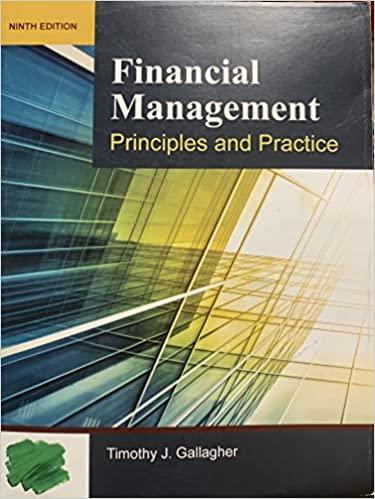Question
Problem 2-14 Historical Returns: Expected and Required Rates of Return You have observed the following returns over time: Year Stock X Stock Y Market 2011
Problem 2-14 Historical Returns: Expected and Required Rates of Return
You have observed the following returns over time:
| Year | Stock X | Stock Y | Market |
| 2011 | 15% | 13% | 13% |
| 2012 | 19 | 7 | 8 |
| 2013 | -18 | -6 | -10 |
| 2014 | 5 | 2 | 2 |
| 2015 | 18 | 13 | 17 |
Assume that the risk-free rate is 6% and the market risk premium is 6%. Do not round intermediate calculations.
- What is the beta of Stock X? Round your answer to two decimal places. What is the beta of Stock Y? Round your answer to two decimal places.
- What is the required rate of return on Stock X? Round your answer to one decimal place. % What is the required rate of return on Stock Y? Round your answer to one decimal place. %
- What is the required rate of return on a portfolio consisting of 80% of Stock X and 20% of Stock Y? Round your answer to one decimal place. %
Problem 3-5 Characteristic Line and Security Market Line
You are given the following set of data:
| HISTORICAL RATES OF RETURN | ||||
| Year | NYSE | Stock X | ||
| 1 | - 26.5% | - 10.0% | ||
| 2 | 37.2 | 21.0 | ||
| 3 | 23.8 | 13.5 | ||
| 4 | - 7.2 | 6.0 | ||
| 5 | 6.6 | 10.8 | ||
| 6 | 20.5 | 16.8 | ||
| 7 | 30.6 | 16.7 | ||
- Use a spreadsheet (or a calculator with a linear regression function) to determine Stock X's beta coefficient. Round your answer to two decimal places. Beta =
- Determine the arithmetic average rates of return for Stock X and the NYSE over the period given. Calculate the standard deviations of returns for both Stock X and the NYSE. Round your answers to two decimal places.
Stock X NYSE Average return, % % Standard deviation, % % - Assume that the situation during Years 1 to 7 is expected to prevail in the future (i.e., , , and both x and bx in the future will equal their past values). Also assume that Stock X is in equilibrium - that is, it plots on the Security Market Line. What is the risk-free rate? Round your answer to two decimal places. %
Problem 3-6 Characteristic Line
You are given the following set of data:
| Historical Rates of Return | |||||
| Year | NYSE | Stock Y | |||
| 1 | 4.0 | % | 4.5 | % | |
| 2 | 14.3 | 22.8 | |||
| 3 | 19.0 | 11.3 | |||
| 4 | - 14.7 | - 8.0 | |||
| 5 | - 26.5 | - 16.6 | |||
| 6 | 37.2 | 34.9 | |||
| 7 | 23.8 | 6.4 | |||
| 8 | - 7.2 | 3.5 | |||
| 9 | 6.6 | 14.9 | |||
| 10 | 20.5 | 22.5 | |||
| 11 | 30.6 | 19.0 | |||
| Mean = | 9.8 | % | 10.5 | % | |
| = | 19.6 | % | 14.7 | %
| |
A) Give a verbal interpretation of what the regression line and the beta coefficient show about Stock Y's volatility and relative risk as compared with those of other stocks. Round your answers to the nearest whole. Stock Y is about percent as volatile as the market; thus, its relative risk is about percent of that of an average firm.
Problem 4-12 Bond Yields and Rates of Return
A 25-year, 8% semiannual coupon bond with a par value of $1,000 may be called in 4 years at a call price of $1,100. The bond sells for $950. (Assume that the bond has just been issued.)
- What is the bond's yield to maturity? Round your answer to two decimal places. %
- What is the bond's capital gain or loss yield? Loss should be indicated with minus sign. Round your answer to two decimal places. %
- What is the bond's yield to call? Round your answer to two decimal places. %
Problem 4-21 Bond Valuation and Changes in Maturity and Required Returns
Suppose Hillard Manufacturing sold an issue of bonds with a 10-year maturity, a $1,000 par value, a 10% coupon rate, and semiannual interest payments.
A) Suppose that 2 years after the initial offering, the going interest rate had risen to 14%. At what price would the bonds sell? Round the answer to the nearest cent.
Step by Step Solution
There are 3 Steps involved in it
Step: 1

Get Instant Access to Expert-Tailored Solutions
See step-by-step solutions with expert insights and AI powered tools for academic success
Step: 2

Step: 3

Ace Your Homework with AI
Get the answers you need in no time with our AI-driven, step-by-step assistance
Get Started


